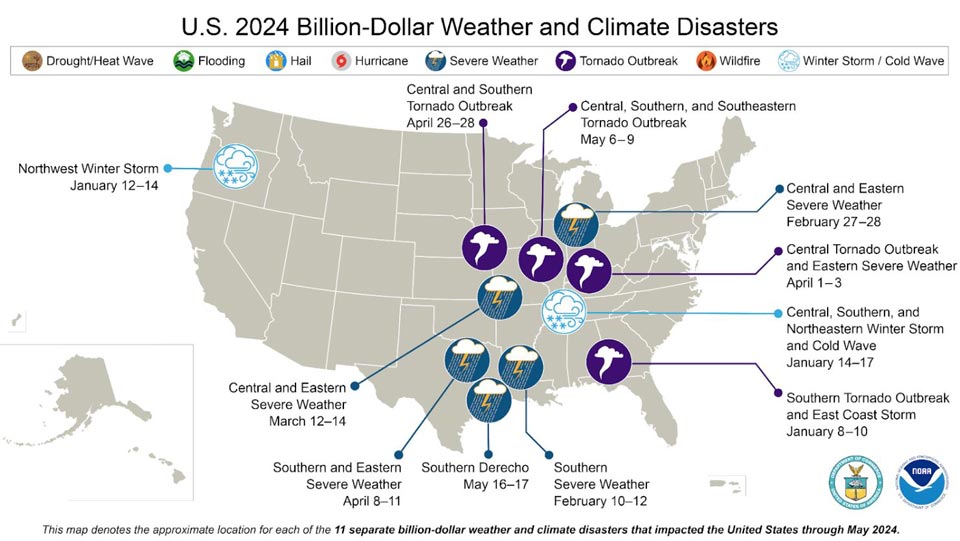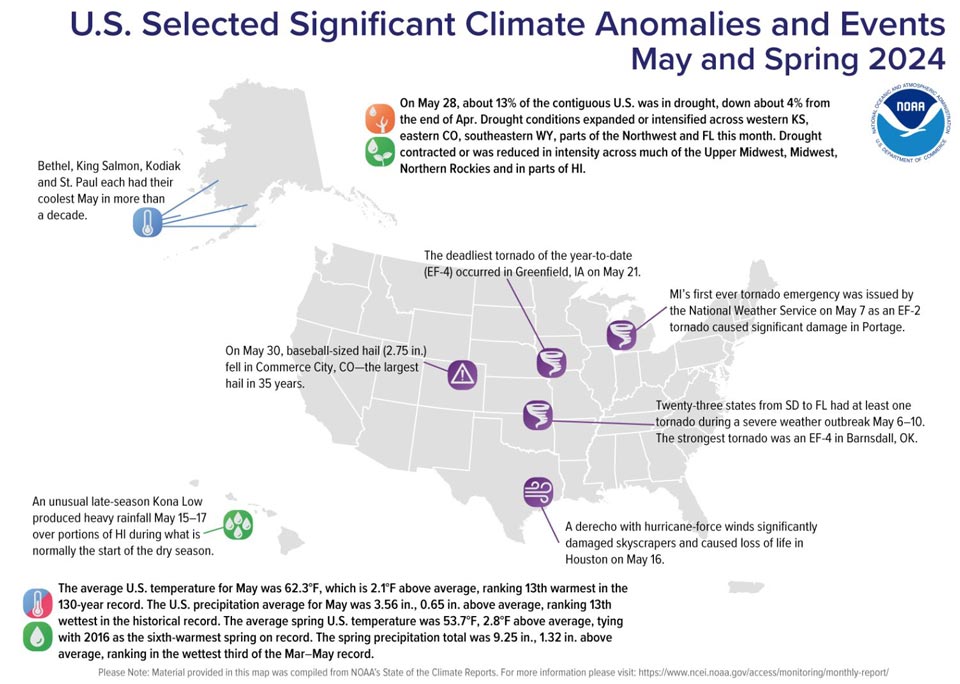June 11, 2024 - May 2024 was a turbulent month across the contiguous U.S., as storms continued their spring onslaught.
The month also added more billion-dollar disasters to the growing list of disasters NOAA has tracked throughout the year.
Below are highlights from NOAA's U.S. monthly climate report for May 2024:
Climate by the numbers
May 2024
The average May temperature across the contiguous U.S. was 62.3 degrees F (2.1 degrees above the 20th-century average), ranking as the 13th-warmest May in NOAA’s 130-year climate record.
May temperatures were above average across much of the eastern contiguous U.S., including Florida, which saw its warmest May on record. Thirteen additional states had their top-10 warmest May on record.
The average precipitation for May was 3.56 inches (0.65 of an inch above average), which ranked as the nation’s 13th-wettest May on record.
Precipitation was above normal in portions of the Plains, the South and the Tennessee Valley. Kentucky, Rhode Island and Tennessee each had their sixth-wettest May on record. Elsewhere in the nation, precipitation was below average across much of the Southwest and southern Florida.
Meteorological spring (March – May 2024) | Year to date
The average temperature for the contiguous U.S. during meteorological spring was 53.7 degrees F (2.8 degrees above average), which tied with 2016 as the sixth-warmest spring on record. Arkansas, Kentucky, Ohio, Virginia and West Virginia each had their second-warmest spring on record, while an additional 21 states ranked within the top-five warmest springs.
The spring precipitation total of 9.25 inches (1.32 inches above average) placed it in the wettest third of the record. Rhode Island saw its third-wettest spring on record and Iowa and Wisconsin their fourth wettest. Five additional states — Connecticut, Louisiana, Massachusetts, Minnesota and Pennsylvania — each saw their top-10 wettest springs on record.
The average U.S. temperature for the year to date (YTD, January through May 2024) was 46.8 degrees F, 3.4 degrees F above average, ranking as the fifth-warmest such YTD on record.
Precipitation for the first five months of 2023 totaled 14.57 inches — 2.19 inches above average — ranking as the ninth-wettest such YTD on record.
Billion-dollar disasters

There were 11 individual billion-dollar weather and climate events across the U.S. during the first five months of 2024, each with losses exceeding $1 billion. These disasters consisted of nine severe storm events and two winter storms. The total cost of these events exceeds $25 billion, and they have resulted in at least 84 fatalities.
Since 1980, the U.S. has sustained 387 separate weather and climate disasters where overall damages/costs reached or exceeded $1 billion (including Consumer Price Index adjustment to 2024). The total cost of these 387 events exceeds $2.740 trillion.
Other notable climate events

May capped off a stormy spring season: A preliminary count of 450 tornadoes spun across the U.S. in March and April combined, with May bringing many more tornadoes and destructive storms to parts of the U.S.
- May 6-10: Twenty-three states from South Dakota to Florida reported at least one tornado, including an EF-4, during a severe weather outbreak that caused significant damage and loss of life.
- May 16: A derecho with winds of up to 100 mph occurred on in Houston, Texas, causing significant damage and at least eight fatalities.
- May 21: The deadliest single tornado of the year to date hit Greenfield, Iowa. The EF-4 tornado caused widespread destruction and five fatalities.
- May 28: NOAA’s National Weather Service issued a warning for DVD-sized hail (5 inches in diameter) for Hockley County, Texas, making it the first warning for hail that large on record.
Drought improved across the country: According to the May 28 U.S. Drought Monitor report,offsite link approximately 13.0% of the contiguous U.S. was in drought, down about 4% from the end of April 2024. Drought coverage expanded or intensified across western Kansas, eastern Colorado, southeastern Wyoming, parts of the Northwest and Florida last month. Drought coverage reduced or lessened in intensity across much of the Upper Midwest, Midwest, Northern Rockies and in parts of Hawaii.
More > Access NOAA’s latest climate report and download the images.
Source: NOAA








